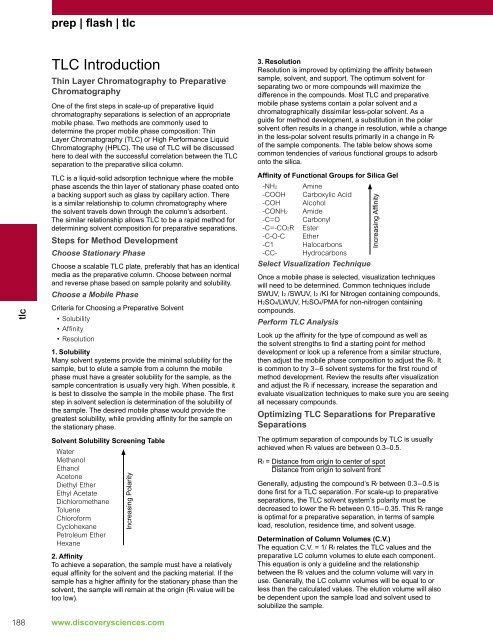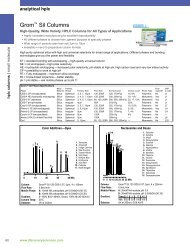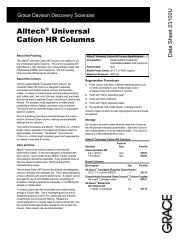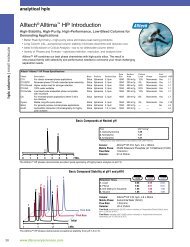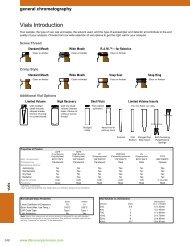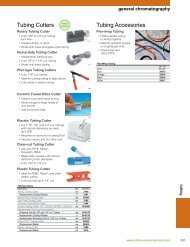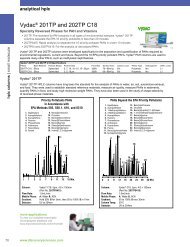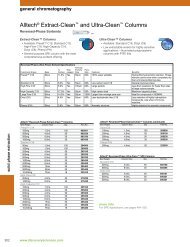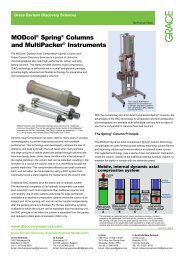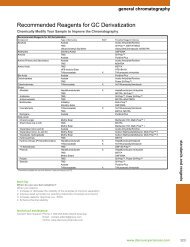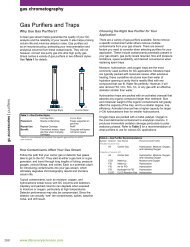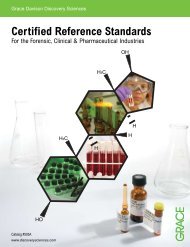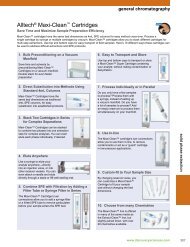TLC Introduction - Grace Davison Discovery Sciences
TLC Introduction - Grace Davison Discovery Sciences
TLC Introduction - Grace Davison Discovery Sciences
You also want an ePaper? Increase the reach of your titles
YUMPU automatically turns print PDFs into web optimized ePapers that Google loves.
tlc<br />
prep | flash | tlc<br />
<strong>TLC</strong> <strong>Introduction</strong><br />
Thin Layer Chromatography to Preparative<br />
Chromatography<br />
One of the first steps in scale-up of preparative liquid<br />
chromatography separations is selection of an appropriate<br />
mobile phase. Two methods are commonly used to<br />
determine the proper mobile phase composition: Thin<br />
Layer Chromatography (<strong>TLC</strong>) or High Performance Liquid<br />
Chromatography (HPLC). The use of <strong>TLC</strong> will be discussed<br />
here to deal with the successful correlation between the <strong>TLC</strong><br />
separation to the preparative silica column.<br />
<strong>TLC</strong> is a liquid-solid adsorption technique where the mobile<br />
phase ascends the thin layer of stationary phase coated onto<br />
a backing support such as glass by capillary action. There<br />
is a similar relationship to column chromatography where<br />
the solvent travels down through the column’s adsorbent.<br />
The similar relationship allows <strong>TLC</strong> to be a rapid method for<br />
determining solvent composition for preparative separations.<br />
Steps for Method Development<br />
Choose Stationary Phase<br />
Choose a scalable <strong>TLC</strong> plate, preferably that has an identical<br />
media as the preparative column. Choose between normal<br />
and reverse phase based on sample polarity and solubility.<br />
Choose a Mobile Phase<br />
Criteria for Choosing a Preparative Solvent<br />
• Solubility<br />
• Affinity<br />
• Resolution<br />
1. Solubility<br />
Many solvent systems provide the minimal solubility for the<br />
sample, but to elute a sample from a column the mobile<br />
phase must have a greater solubility for the sample, as the<br />
sample concentration is usually very high. When possible, it<br />
is best to dissolve the sample in the mobile phase. The first<br />
step in solvent selection is determination of the solubility of<br />
the sample. The desired mobile phase would provide the<br />
greatest solubility, while providing affinity for the sample on<br />
the stationary phase.<br />
Solvent Solubility Screening Table<br />
Water<br />
Methanol<br />
Ethanol<br />
Acetone<br />
Diethyl Ether<br />
Ethyl Acetate<br />
Dichloromethane<br />
Toluene<br />
Chloroform<br />
Cyclohexane<br />
Petroleum Ether<br />
Hexane<br />
Increasing Polarity<br />
2. Affinity<br />
To achieve a separation, the sample must have a relatively<br />
equal affinity for the solvent and the packing material. If the<br />
sample has a higher affinity for the stationary phase than the<br />
solvent, the sample will remain at the origin (Rf value will be<br />
too low).<br />
188 www.discoverysciences.com<br />
3. Resolution<br />
Resolution is improved by optimizing the affinity between<br />
sample, solvent, and support. The optimum solvent for<br />
separating two or more compounds will maximize the<br />
difference in the compounds. Most <strong>TLC</strong> and preparative<br />
mobile phase systems contain a polar solvent and a<br />
chromatographically dissimilar less-polar solvent. As a<br />
guide for method development, a substitution in the polar<br />
solvent often results in a change in resolution, while a change<br />
in the less-polar solvent results primarily in a change in Rf<br />
of the sample components. The table below shows some<br />
common tendencies of various functional groups to adsorb<br />
onto the silica.<br />
Affinity of Functional Groups for Silica Gel<br />
-NH2 Amine<br />
-COOH Carboxylic Acid<br />
-COH Alcohol<br />
-CONH2 Amide<br />
-C=O Carbonyl<br />
-C=-CO2R Ester<br />
-C-O-C Ether<br />
-C1 Halocarbons<br />
-CC- Hydrocarbons<br />
Select Visualization Technique<br />
Once a mobile phase is selected, visualization techniques<br />
will need to be determined. Common techniques include<br />
SWUV, I2 /SWUV, I2 /KI for Nitrogen containing compounds,<br />
H2SO4/LWUV, H2SO4/PMA for non-nitrogen containing<br />
compounds.<br />
Perform <strong>TLC</strong> Analysis<br />
Increasing Affinity<br />
Look up the affinity for the type of compound as well as<br />
the solvent strengths to find a starting point for method<br />
development or look up a reference from a similar structure,<br />
then adjust the mobile phase composition to adjust the Rf. It<br />
is common to try 3–6 solvent systems for the first round of<br />
method development. Review the results after visualization<br />
and adjust the Rf if necessary, increase the separation and<br />
evaluate visualization techniques to make sure you are seeing<br />
all necessary compounds.<br />
Optimizing <strong>TLC</strong> Separations for Preparative<br />
Separations<br />
The optimum separation of compounds by <strong>TLC</strong> is usually<br />
achieved when Rf values are between 0.3–0.5.<br />
Rf = Distance from origin to center of spot<br />
Distance from origin to solvent front<br />
Generally, adjusting the compound’s Rf between 0.3–0.5 is<br />
done first for a <strong>TLC</strong> separation. For scale-up to preparative<br />
separations, the <strong>TLC</strong> solvent system’s polarity must be<br />
decreased to lower the Rf between 0.15–0.35. This Rf range<br />
is optimal for a preparative separation, in terms of sample<br />
load, resolution, residence time, and solvent usage.<br />
Determination of Column Volumes (C.V.)<br />
The equation C.V. = 1/ Rf relates the <strong>TLC</strong> values and the<br />
preparative LC column volumes to elute each component.<br />
This equation is only a guideline and the relationship<br />
between the Rf values and the column volume will vary in<br />
use. Generally, the LC column volumes will be equal to or<br />
less than the calculated values. The elution volume will also<br />
be dependent upon the sample load and solvent used to<br />
solubilize the sample.
<strong>TLC</strong> Plates<br />
Davisil ® Silica <strong>TLC</strong> Plates<br />
• Made with the same Davisil ® silica as sold in<br />
bulk for easy method development<br />
• Scored to customize to your plate size preference<br />
Davisil ® Silica <strong>TLC</strong> Plates<br />
Description Layer Thickness Qty. Part No.<br />
Hard Layer, Organic Binder, Fluorescent Indicator, 254nm<br />
Scored, 4, 5 x 20cm Sections<br />
20 x 20cm 250µm 25 8617580<br />
Scored, 8, 2.5 x 10cm Sections<br />
10 x 20cm 250µm 25 8617610<br />
3179<br />
<strong>Grace</strong> has a large<br />
selection of <strong>TLC</strong> plates<br />
to suit your separation<br />
needs.<br />
Silica<br />
<strong>Grace</strong>Resolv Silica <strong>TLC</strong> Plates<br />
• Made with the same high-purity Davisil ® silica as used<br />
in the <strong>Grace</strong>Resolv flash cartridges for easy method<br />
development<br />
• Scored to customize to your plate size preference<br />
<strong>Grace</strong>Resolv Silica <strong>TLC</strong> Plates<br />
Description Layer Thickness Qty. Part No.<br />
Hard Layer, Organic Binder, Fluorescent Indicator, 254nm<br />
Scored, 4, 5 x 20cm Sections<br />
20 x 20cm 250µm 25 8618900<br />
5369<br />
3<br />
2<br />
1<br />
7087<br />
1. Progesterone<br />
2. Testosterone<br />
3. Hydrocortisone<br />
Prep-Screen Sol. System:<br />
Methanol:Water (70:30)<br />
HPLC Sol. System:<br />
Methanol:Water (70:30)<br />
prep | flash | tlc<br />
Alltech ® Prep-Screen <strong>TLC</strong> Plates<br />
• Made with the 10–12µm spherical silica gel used for<br />
Alltech ® prep-HPLC cartridge columns<br />
• Available in both Econosphere silica gel and C18<br />
(reversed-phase) bonded versions<br />
Prep-Screen HP<strong>TLC</strong> Plates help to optimize sample<br />
separation parameters for use in preparative HPLC. These<br />
plates allow a quick, inexpensive preview of sample traits in<br />
various mobile phase systems prior to HPLC analysis. The<br />
adsorbent is the same Econosphere silica or C18 used in<br />
Alltech packed HPLC columns.<br />
Prep-Screen C18<br />
Econo-Prep HPLC<br />
3<br />
www.discoverysciences.com<br />
2<br />
7065<br />
Prep Screen HP<strong>TLC</strong> Plates<br />
Description Qty. Part No.<br />
Prep-Screen HP<strong>TLC</strong> Plates, 10 x 10cm, 200µm Layer<br />
Silica Gel, 10µm Spherical Adsorbent 10 16328<br />
C18, 10µm Spherical Adsorbent 10 16332<br />
technical assistance<br />
Contact Tech Support: Phone: 1.800.255.8324 (North America)<br />
Email: contact.alltech@grace.com<br />
Online: www.discoverysciences.com<br />
related products<br />
See pages 194–198 for tanks, sprayers, applicators, and other<br />
<strong>TLC</strong> accessories.<br />
1<br />
tlc<br />
189
tlc<br />
prep | flash | tlc<br />
<strong>TLC</strong> Plates<br />
Alltech ® Prekotes<br />
• High purity silica gel for increased sensitivity<br />
• Controlled particle size for faster separations and<br />
improved resolution (>80% in 6–15µm range)<br />
• Precoated plates provide convenience and superior<br />
layer quality<br />
Adsorbosil ® -Plus<br />
Silica Gel H<br />
(Soft Layer)<br />
+ CaSO 4<br />
190 www.discoverysciences.com<br />
Adsorbosil ® -Plus 1<br />
Silica Gel G<br />
(Soft Layer)<br />
Soft Layer<br />
• Contains no organic binders<br />
• Sample zones are easy to remove for further analysis<br />
Soft Layer Adsorbosil ® Prekotes<br />
Description Qty. Part No.<br />
Soft Layer Prekotes, Glass-Backed<br />
Conventional, 250µm Layer Thickness, 20 x 20cm<br />
Adsorbosil ® -Plus 25 16384<br />
Adsorbosil ® -Plus P* 25 16376<br />
Adsorbosil ® -Plus 1 25 16330<br />
Adsorbosil ® -Plus 1 P* 25 16322<br />
*P = With Fluorescent Indicator, 254 wavelength.<br />
Hard Layer<br />
• Contains a proprietary inorganic binder to add abrasion<br />
resistance to layer<br />
• Use when strong charring is required for visualization<br />
• Write on layer with pencil or felt pen<br />
• Sample zones can be removed for further analysis<br />
Hard Layer Adsorbosil ® Prekotes<br />
Description Qty. Part No.<br />
Hard Layer Prekotes, Glass-Backed<br />
Conventional, 250µm Layer Thickness, 20 x 20cm<br />
Adsorbosil ® -Plus 1 25 16324<br />
Adsorbosil ® -Plus 1 P* 25 16326<br />
*P = With Fluorescent Indicator, 254 wavelength.<br />
Adsorbosil ® HP<strong>TLC</strong> Plates<br />
• 150µm layer thickness for fast, high resolution separations<br />
• Smooth surface for noise-free densitometry<br />
HP<strong>TLC</strong> with Inorganic Binder<br />
• Allows use of 100% water in the solvent system<br />
• Use when strong charring is required<br />
High-Performance <strong>TLC</strong> Plates<br />
Description Qty. Part No.<br />
Adsorbosil ® -Plus 1 Plates with Inorganic Binder, 10 x 10cm<br />
Adsorbosil ® -Plus 1P HP<strong>TLC</strong>, with F254<br />
UV Indicator<br />
25 16401<br />
Reversed-Phase HP<strong>TLC</strong> Plates<br />
• Coated with non-polar, C18 chemically bonded support<br />
• Cross-linked organic polymer binder makes an abrasion<br />
resistant layer and a smooth surface<br />
• Use to separate mixtures of lipophilic components,<br />
hydrocarbons, fats and waxes, fat soluble vitamins<br />
or steroids<br />
1 2 3<br />
Fatty Acid Separation<br />
1. Methyl Oleate<br />
2. Methyl Linoleate<br />
3. Methyl Linolenate<br />
<strong>TLC</strong> Plate: Adsorbosil ® RP HP<strong>TLC</strong> (Part No. 16314)<br />
Sol. System: Acetonitrile:Acetic Acid:Water (70:10:1)<br />
Development Time: 25min<br />
Visualization: Iodine Vapor<br />
7088<br />
High-Performance <strong>TLC</strong> Plates<br />
Description Qty. Part No.<br />
Reversed-Phase C18 HP<strong>TLC</strong>, 150µm Layer Thickness<br />
Adsorbosil ® RP HP<strong>TLC</strong>, 10 x 10cm 25 16314<br />
Adsorbosil ® RP HP<strong>TLC</strong> Plates with F254,<br />
10 x 10cm<br />
25 16315<br />
Adsorbosil ® RP HP<strong>TLC</strong> Plates, Prescored,<br />
10 x 20cm<br />
25 16318<br />
Adsorbosil ® RP HP<strong>TLC</strong> Plates, Prescored,<br />
with F254, 10 x 20cm<br />
25 16319
<strong>TLC</strong> Plates<br />
Macherey-Nagel<br />
Silica Gel Plates<br />
• 60Å pore size<br />
• Particle size, 5 to 17µm<br />
• Binder is organic, stable in most organic solvents and<br />
aggressive detection reagents<br />
Glass-Backed Macherey-Nagel <strong>TLC</strong> Plates<br />
Description Size Layer Qty. Part No.<br />
Silica Gel Plates, Glass-Backed<br />
Conventional Layers, Silica Gel 60<br />
SIL G-25 5 x 10cm 250µm 50 809017<br />
SIL G-25 5 x 20cm 250µm 100 809011<br />
SIL G-25 20 x 20cm 250µm 25 809013<br />
SIL G-25 UV254 5 x 20cm 250µm 100 809021<br />
SIL G-25 UV254 20 x 20cm 250µm 25 809023<br />
SIL G-25 UV254+366 20 x 20cm 250µm 25 809123<br />
Preparative Layers<br />
SIL G-100 UV254 20 x 20cm 1000µm 15 809063<br />
SIL G-200 UV254 20 x 20cm 2000µm 12 809083<br />
Specialty Plates<br />
• Silica Gel and Cellulose—Specific for separation of<br />
food preservatives<br />
• Silica Gel—Specific for aflatoxin analysis<br />
Specialty Plates<br />
Description Size Layer Qty. Part No.<br />
Specialty Plates, Glass-Backed<br />
Silica Gel and Cellulose — Mixed Layer<br />
SILCEL-Mix-25 UV254 20 x 20cm 250µm 25 810043<br />
Silica Gel Highly Purified with Gypsum<br />
SIL G-25 HR 20 x 20cm 250µm 25 809033<br />
SIL G-25 HR UV254 20 x 20cm 250µm 25 809043<br />
related products<br />
Performing flash separations?<br />
See <strong>Grace</strong>Resolv flash consumable product line on<br />
pages 184–187.<br />
prep | flash | tlc<br />
Nano-Series HP<strong>TLC</strong> Plates<br />
• Particle size, 2–10µm<br />
• Higher speed<br />
• Better resolution and sensitivity than regular <strong>TLC</strong> plates<br />
Nano-SIL HP<strong>TLC</strong> Plates<br />
Description Size Layer Qty. Part No.<br />
Nano-Series HP<strong>TLC</strong> Plates, Glass-Backed<br />
Silica Gel 60<br />
Nano-SIL-20 10 x 20cm 200µm 50 811013<br />
Nano-SIL-20/UV254 10 x 20cm 200µm 50 811023<br />
Nano-Series HP<strong>TLC</strong> Plates, Aluminum-Backed*<br />
Silica Gel 60<br />
Nano-SIL G 20 x 20cm 200µm 25 818141<br />
Nano-SIL G/UV254 20 x 20cm 200µm 25 818143<br />
*Do not use with mineral acids or concentrated ammonia.<br />
technical assistance<br />
Contact Tech Support: Phone: 1.800.255.8324 (North America)<br />
Email: contact.alltech@grace.com<br />
Online: www.discoverysciences.com<br />
www.discoverysciences.com<br />
tlc<br />
191
tlc<br />
prep | flash | tlc<br />
<strong>TLC</strong> Plates<br />
Macherey-Nagel Polygram ® Series<br />
Silica Gel 60<br />
• SIL G and SIL N layers have different binders and show<br />
different separation characteristics<br />
Cellulose, Avicel-Microcrystalline<br />
Cellulose MN 300—Native Fibrous Cellulose<br />
• Fibers are 2–20µm in length<br />
Cellulose, Ion-Exchanger<br />
• DEAE carries positive charges at neutral and acidic pH<br />
• Use DEAE to separate proteins, enzymes, and hormones<br />
• Use PEI to analyze nucleic acids<br />
Polyamide 6<br />
• Specific for separation of dansyl and DNP amino acids<br />
Polygram ® Flexible-Backed <strong>TLC</strong> Plates<br />
Description Size Layer Qty. Part No.<br />
Polyester-Backed <strong>TLC</strong> Plates<br />
Silica Gel 60<br />
SIL G 20 x 20cm 250µm 25 805013<br />
SIL G/UV254 4 x 8cm 250µm 50 805021<br />
SIL G/UV 254 20 x 20cm 250µm 25 805023<br />
SIL N-HR/UV254 20 x 20cm 200µm 25 804023<br />
Cellulose Plates<br />
Cellulose MN 400, Avicel-Microcrystalline Cellulose<br />
CEL 400 20 x 20cm 100µm 25 801113<br />
CEL 400 UV254 20 x 20cm 100µm 25 801123<br />
Cellulose MN 300<br />
CEL 300 20 x 20cm 100µm 25 801013<br />
CEL 300 UV254 20 x 20cm 100µm 25 801023<br />
Cellulose, Ion-Exchanger<br />
CEL 300 DEAE 20 x 20cm 100µm 25 801073<br />
CEL 300 PEI* 20 x 20cm 100µm 25 801053<br />
CEL 300 PEI/UV254 20 x 20cm 100µm 25 801063<br />
Specialty Polyester-Backed Plates<br />
Polyamide 6<br />
POLYAMIDE 6 20 x 20cm 100µm 25 803013<br />
POLYAMIDE 6 UV254 20 x 20cm 100µm 25 803023<br />
*PEI plates must be refrigerated.<br />
192 www.discoverysciences.com<br />
Hybrid Plates<br />
• “Wettable” RP plate<br />
• For both reversed- and normal-phase chromatography<br />
• Determine polarity by eluent selection<br />
• Activate layer at 110–115°C prior to use<br />
• Particle size of 2–10µm for improved separations<br />
Hybrid <strong>TLC</strong> Plates<br />
Description Layer Qty. Part No.<br />
Silica Gel RP18/UV254s* Plates, Aluminum-Backed<br />
4 x 8cm 150µm 50 818144<br />
5 x 20cm 150µm 50 818145<br />
20 x 20cm 150µm 25 818146<br />
*Acid-resistant fluorescent indicator.<br />
technical assistance<br />
Contact Tech Support: Phone: 1.800.255.8324 (North America)<br />
Email: contact.alltech@grace.com<br />
Online: www.discoverysciences.com
Analtech <strong>TLC</strong> Plates<br />
Silica Gel H and HF Uniplates<br />
• Soft Layer<br />
– Contains no organic binder<br />
– Contains no calcium sulfate binder<br />
• Hard Layer<br />
– Contains an organic binder<br />
– 80% water resistant<br />
– Visualization by charring up to 150°C<br />
Silica Gel H and HF Uniplates<br />
Layer<br />
Description<br />
Thickness Qty.<br />
H<br />
Part No.<br />
HP<strong>TLC</strong> Uniplates<br />
• Smooth surface gives a high signal-to-noise ratio for<br />
increased sensitivity and precision<br />
• High resolution separations in five minutes<br />
• Ideal for densitometric scanning<br />
HF*<br />
Part No.<br />
Soft Layer, No Binders<br />
Conventional<br />
20 x 20cm 250µm 25 710011 720011<br />
10 x 20cm 250µm 25 710021 7200210<br />
Hard Layer, Organic Binder<br />
Conventional<br />
20 x 20cm 250µm 25 746011 747011<br />
10 x 20cm 250µm 25 746021 747021<br />
Scored, Four 5 x 20cm Sections or Eight, 2.5 x 10cm Sections<br />
20 x 20cm 250µm 25 — 747511<br />
10 x 20cm 250µm 25 — 747521<br />
*F-Fluorescent Indicator, 254nm.<br />
HP<strong>TLC</strong> Uniplates<br />
Description<br />
Layer<br />
Thickness Qty. Part No.<br />
HP<strong>TLC</strong> Silica Gel with Inorganic Binder<br />
10 x 10cm, HP-GHL 150µm 25 756077<br />
10 x 10cm, HP-GHLF* 150µm 25 757077<br />
Reversed-Phase HP<strong>TLC</strong> Unibond**<br />
10 x 10cm, HP-RP18F<br />
*F-Fluorescent Indicator, 254nm.<br />
150µm 25 763077<br />
**Due to the extreme hydrophobic nature of the RP18 adsorbent, aqueous wettability is<br />
limited to approximately 60% water in the mobile phase. (see www.analtech.com)<br />
prep | flash | tlc<br />
Silica Gel G and GF Uniplates<br />
• Calcium Sulfate Binder<br />
• Soft Layer<br />
– Contains no organic binder<br />
• Hard Layer<br />
– Contains an inorganic binder<br />
– 100% water resistant<br />
– Visualization with strong charring reagents<br />
– Abrasion resistant<br />
Silica Gel G Uniplates<br />
Description<br />
Layer<br />
Thickness Qty.<br />
G<br />
Part No.<br />
GF*<br />
Part No.<br />
Soft Layer, No Binders<br />
Conventional<br />
20 x 20cm 250µm 25 701011 702011<br />
10 x 20cm 250µm 25 701021 702021<br />
Preadsorbent<br />
20 x 20cm 250µm 25 731011 732011<br />
Preparative Uniplates, Soft Layer<br />
Conventional Prep<br />
20 x 20cm 500µm 25 — 702012<br />
20 x 20cm 1000µm 25 — 702013<br />
20 x 20cm 1500µm 25 — 702014<br />
20 x 20cm 2000µm 25 — 702015<br />
Hard Layer, Inorganic Binder<br />
Conventional<br />
20 x 20cm 250µm 25 711011 721011<br />
10 x 20cm 250µm 25 711021 721021<br />
*F-Fluorescent Indicator, 254nm.<br />
related products<br />
Looking for a fast and easy way to score<br />
your own <strong>TLC</strong> plates?<br />
See our <strong>TLC</strong> plate cutter on page 196.<br />
3923<br />
www.discoverysciences.com<br />
tlc<br />
193
tlc<br />
prep | flash | tlc<br />
<strong>TLC</strong> Tanks and Storage<br />
Cylindrical <strong>TLC</strong> Tanks<br />
• Requires minimal solvent usage<br />
• Glass cylindrical tanks with press-on lids<br />
Cylindrical <strong>TLC</strong> Tanks<br />
Description Part No.<br />
Cylindrical <strong>TLC</strong> Tanks for 5 x 10mm and 4 x 8cm Plates, 17108<br />
2.5" o.d., 5" Height<br />
Cylindrical <strong>TLC</strong> Tanks for 5 x 20cm Plates, 2.5" o.d.,<br />
17107<br />
9" Height<br />
Cylindrical <strong>TLC</strong> Tanks for 10 x 20cm Plates, 5" o.d.,<br />
17002<br />
9" Height<br />
Latch-Lid <strong>TLC</strong> Chromatotank<br />
• Unique latching device assures tight<br />
seal between lid and tank<br />
• No messy “grease” seals<br />
The unique latching device holds the<br />
matching ground glass surfaces of the<br />
lid and tank firmly in place to maintain an<br />
optimal equilibration atmosphere. The metal components<br />
of the Latch-Lid mechanism are made of stainless steel.<br />
Multiple Plate Development Rack<br />
• Saves time and money<br />
• Choice of anodized aluminum or PTFE<br />
resin-coated rack<br />
• Sizes available to hold six 20 x 20cm or<br />
six 10 x 10cm plates<br />
194 www.discoverysciences.com<br />
best<br />
seller<br />
Latch-Lid Chromatotank<br />
Description Part No.<br />
Standard Latch-Lid Tank/Lid Unit, 10 x 10cm Plates 7542<br />
Latch-Lid Tank/Lid Unit, 20 x 20cm Plates 7536<br />
Multiple Plate Development Rack<br />
Description Part No.<br />
Anodized Aluminum Rack for 20 x 20cm Plates 17051<br />
Anodized Aluminum Rack for 10 x 10cm Plates 17053<br />
5341<br />
5350<br />
5349<br />
Rectangular <strong>TLC</strong> Tanks<br />
• Unique beveled lip to<br />
eliminate sharp edges<br />
• Uniform flat top for maximum<br />
lid seal<br />
This Rectangular <strong>TLC</strong> Tank is<br />
a heavy wall, clear glass block<br />
with flat surface walls. Lids are<br />
polished glass in sizes to match<br />
the tank dimensions.<br />
Rectangular <strong>TLC</strong> Tanks<br />
Description Part No.<br />
Rectangular Tanks, All Supplied with Glass Lid<br />
Thinline Tank for 10 x 10cm Plates,<br />
7581<br />
(12cm x 11.5m x 6.4cm), (4.75" x 4.5" x 2.5")<br />
Standard Tank for 10 x 10cm Plates,<br />
7550<br />
(12cm x 11.5cm x 8.6cm), (4.75" x 4.5" x 3.37")<br />
Standard Tank for 20 x 20cm Plates,<br />
7645<br />
(27cm x 24cm x 7cm), (10.5" x 10" x 3")<br />
Standard Tank for 10 x 20cm Plates,<br />
7582<br />
(27cm x 13cm x 7cm), (10.5" x 5" x 3")<br />
Standard Tank for 5 x 5cm Plates,<br />
7580<br />
(17cm x 15cm x 8cm), (7" x 6" x 3")<br />
<strong>TLC</strong> Tank Pads<br />
• Medium weight lint-free pads for<br />
<strong>TLC</strong> tank liners<br />
<strong>TLC</strong> Pads<br />
Description Part No.<br />
20 x 20cm, Medium Weight, 100/pk 7630<br />
tech tip<br />
Rectangular <strong>TLC</strong> Tank Dimensions<br />
• All are inside dimensions<br />
• Listed as height x width x depth<br />
D<br />
H<br />
W<br />
5346<br />
5345<br />
0571
Sprayers<br />
Compressed Gas Sprayer<br />
• Replaceable pressure unit<br />
• Refillable sprayer<br />
• Reusable glass or plastic<br />
container<br />
Compressed Gas Sprayers<br />
provide a constant pressure and<br />
uniform distribution of fine mist<br />
on your <strong>TLC</strong> plate. The pressure<br />
unit contains difluoroethane.<br />
Unit sprays up to 16oz of liquid.<br />
Caution: Wetted parts are made<br />
of polypropylene or nylon. Do not<br />
store with dip tube immersed in reagent.<br />
Safety Top Screw Cap Sprayer<br />
• Made of borosilicate glass<br />
• Autoclavable<br />
Safety Top Sprayers adjust<br />
the mist by covering the rear<br />
vent hole with a thumb. The<br />
atomizer tops are attached to<br />
the reservoir flasks with a screw<br />
top and o-ring. The screw top<br />
delivers a positive seal between<br />
sprayer head and reservoir,<br />
eliminating the possibility<br />
of “blow back”. Remove the<br />
screw cap and o-ring prior to<br />
autoclaving. Operation of the<br />
unit is by low air pressure (5lb).<br />
best<br />
seller<br />
Compressed Gas Sprayer<br />
Description Qty. Part No.<br />
Complete Spray Unit with Glass Jar 3 14654<br />
Replacement Glass Jar with Lid 6 14655<br />
Replacement Compressed Gas Unit 6 14657<br />
Safety Top Sprayer with Screw Cap<br />
Description Qty. Part No.<br />
50mL ea 14545<br />
125mL ea 14550<br />
250mL ea 14555<br />
5329<br />
5332<br />
Spraying Accessories<br />
Disposable Spray Box<br />
• Opens easily into 14"L x 14"W x 14"H<br />
(35.56cm) unit<br />
• Unique design for spill containment<br />
• Heavy duty cardboard with disposal<br />
bag provided<br />
Polypropylene Spray Stand<br />
• Front edge to hold plate for spraying<br />
• Ideal for use in fume hood<br />
prep | flash | tlc<br />
<strong>TLC</strong> Spray Supports<br />
Description Qty. Part No.<br />
Disposable Spray Box 5 16408<br />
Polypropylene Spray Stand ea 7636<br />
5367<br />
5370<br />
www.discoverysciences.com<br />
tlc<br />
195
tlc<br />
prep | flash | tlc<br />
<strong>TLC</strong> Accessories<br />
<strong>TLC</strong> Plate Cutter<br />
• Scores coated glass plates at<br />
any position<br />
• Compact, portable, and easy<br />
to operate<br />
The <strong>TLC</strong> Plate Cutter has a highquality<br />
carbide scriber mounted<br />
into a movable plastic head. It is designed to produce optimal<br />
scoring on the glass surface of 20 x 20cm <strong>TLC</strong> plates with a<br />
total thickness (glass + coating) of 2mm. A smaller template<br />
is included with the unit for ease in cutting 10 x 10cm plates.<br />
<strong>TLC</strong> Plate Cutter<br />
Description Qty. Part No.<br />
<strong>TLC</strong> Plate Cutter ea 7535<br />
Replacement Scribers 1 7565<br />
3 7575<br />
tech tip<br />
Note About Sample Applications<br />
Thorough drying of samples is a step that is often ignored but can<br />
result in development errors. If a small amount of solute is left on<br />
the plate it can interact with the development system and affect<br />
the separation.<br />
Many analysts assume the plate is dry when the solvent is no<br />
longer visible on the plate (5–10 minutes). However, depending<br />
on the volatility of the solvent and the quantity of sample applied,<br />
the drying time can be considerably longer. Generally, Rƒ values<br />
decrease as drying time increases until the dry state (stable Rƒ)<br />
is reached.<br />
Plates can absorb moisture from the atmosphere during storage,<br />
so prior to sample application, all <strong>TLC</strong> plates should be heated<br />
at 120–130°C for about 30–40 minutes and allowed to cool in<br />
a desiccator. This ensures reproducible Rƒ values.<br />
196 www.discoverysciences.com<br />
3923
<strong>TLC</strong> Accessories<br />
Sample Applicators<br />
Drummond ® Microcaps<br />
• Accuracy of ±1%<br />
The Drummond ® Microcap is a<br />
precision bore glass capillary tube<br />
that holds a known volume when<br />
filled by capillary action. The tube is<br />
emptied completely by squeezing<br />
the dispenser bulb. (Bulb is included with the unit.)<br />
Drummond ® Sample Applicators<br />
Description/Capacity Qty. Part No.<br />
Drummond ® Microcaps<br />
0.5µL 100 3808<br />
1.0µL 100 3809<br />
2.0µL 100 3810<br />
5.0µL 100 3814<br />
10.0µL 100 3820<br />
20.0µL 100 3822<br />
Drummond ® Microcap Accessories<br />
Microcap Bulbs 6 3940<br />
Uncalibrated Disposable Micropipettes<br />
Uncalibrated disposable glass<br />
micropipettes are intended for rapid<br />
qualitative sample application on<br />
<strong>TLC</strong> plates. Thick walls make these<br />
pipettes strong and easy to handle.<br />
Overall length is about three inches.<br />
Capacity is approximately 2–8µL.<br />
Uncalibrated Disposable Micropipettes<br />
Description Qty. Part No.<br />
Glass Micropipettes 300 7616<br />
1440 17203<br />
technical assistance<br />
Contact Tech Support: Phone: 1.800.255.8324 (North America)<br />
Email: contact.alltech@grace.com<br />
Online: www.discoverysciences.com<br />
5338<br />
5340<br />
Drummond ® Wiretrol ® Micropipettes<br />
• Combines the accuracy of a<br />
microsyringe with the ease and<br />
economy of a disposable pipette<br />
• Accuracy of ±1%<br />
• Color-coded with a permanent<br />
calibration line<br />
These unique pipetting devices<br />
feature one-handed operation.<br />
Each unit contains a vial of 100<br />
micropipettes, dispenser cap, handle,<br />
and one stainless steel plunger.<br />
prep | flash | tlc<br />
Drummond ® Sample Applicators<br />
Description/Capacity Qty. Part No.<br />
Drummond ® Wiretrol ® Micropipettes<br />
1.0 to 5.0µL (Calibrated) 100 3842<br />
5.0µL 100 3844<br />
10.0µL 100 3845<br />
20.0µL 100 3846<br />
25.0µL 100 3847<br />
5286<br />
www.discoverysciences.com<br />
tlc<br />
197
tlc<br />
prep | flash | tlc<br />
<strong>TLC</strong> Accessories<br />
UV Viewing Cabinet<br />
• Fixed eyepiece with UV<br />
shielded window<br />
• Uses 4- and 6-watt E-series<br />
lamps<br />
The UV Viewing Cabinet measures<br />
6.5" H x 9" W x 12" L (16.5cm H x<br />
22.9cm W x 30.5cm L). This cabinet<br />
cannot be used for photo systems<br />
because of the fixed eyepiece.<br />
UV Viewing Cabinet, Supplied Without Lamps<br />
Description Part No.<br />
UV Viewing Cabinet, Model CM-10 80305<br />
E-Series Ultraviolet Lamps<br />
• Easy to operate<br />
• Choice of intensity, wavelengths,<br />
and sizes<br />
The Spectroline ® E-Series Lamps can be<br />
used as portable units, with UV viewing<br />
cabinets, or in photo darkroom cabinets.<br />
Lamps with a filter assembly provide<br />
maximum fluorescent contrast with the<br />
least white light transmission.<br />
E-Series Lamps<br />
Description Part No.<br />
8-Watt Combo Lamp<br />
LW, SW, and Filter Assembly, 115V 80240<br />
LW, SW, and Filter Assembly, 230V 80245<br />
8-Watt Replacement Parts<br />
LW Replacement Tube 80242<br />
SW Replacement Tube 80244<br />
Combo Light Replacement Filter 80246<br />
6-Watt Combo Lamp<br />
LW, SW, and Filter Assembly, 115V 80250<br />
LW, SW, and Filter Assembly, 230V 80255<br />
6-Watt Replacement Parts<br />
LW Tube Replacement 80252<br />
SW Tube Replacement 80254<br />
Combo Light Filter Replacement 80256<br />
Lamp Accessories<br />
UV Lamp Stand 80218<br />
UV Lamp Handle (not shown) 80219<br />
198 www.discoverysciences.com<br />
5352<br />
5353


